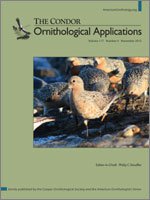In mark–recapture studies conducted on fixed-area study sites, apparent (or “local”) survival (φ) is the product of the probabilities of true survival (S) and site fidelity to the sampling area (F). If marked individuals permanently emigrate from the study site, apparent survival will be biased low relative to true survival. Similarly, estimates of mate fidelity will be biased high because site fidelity is typically higher for individuals that reunite with their previous mates than among pairs that divorce. Here, we develop a method for calculating site fidelity that takes plot boundaries into account, based on a dispersal model estimated from local movements within a fixed study site. We use dispersal estimates to adjust apparent survival and mate fidelity for the effects of short-distance movements out of a fixed area. We demonstrate our method with a retrospective analysis of a published study of 2 species of sandpipers breeding sympatrically at a field site in western Alaska. Estimates of survival probability increased by 0.01–0.03 for males and 0.07–0.08 for females in both species. The larger adjustments for females were expected based on their longer local dispersal movements. Adjusted mate fidelity estimates were lower than the original estimates by 0.04–0.07. Use of local movement data to estimate site fidelity cannot account for permanent emigration due to long-distance movements and, if such movements occur, our adjusted estimates of φ remain a function of true survival and site fidelity. Nevertheless, our method can reduce bias in demographic parameters resulting from local dispersal movements, improving estimates of annual survival and mate fidelity for use in demographic models.
How to translate text using browser tools
30 September 2015
Using local dispersal data to reduce bias in annual apparent survival and mate fidelity
Caz M. Taylor,
David B. Lank,
Brett K. Sandercock
ACCESS THE FULL ARTICLE

The Condor
Vol. 117 • No. 4
November 2015
Vol. 117 • No. 4
November 2015
apparent survival
breeding dispersal
demography
live-encounter data
site fidelity




